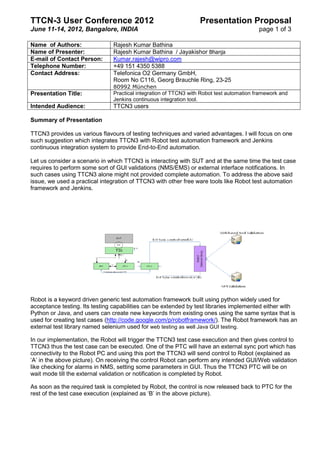
T3UC_PresentationT3UC2012_Rajesh_2
- 1. TTCN-3 User Conference 2012 Presentation Proposal June 11-14, 2012, Bangalore, INDIA page 1 of 3 Name of Authors: Rajesh Kumar Bathina Name of Presenter: Rajesh Kumar Bathina / Jayakishor Bhanja E-mail of Contact Person: Kumar.rajesh@wipro.com Telephone Number: +49 151 4350 5388 Contact Address: Telefonica O2 Germany GmbH, Room No C116, Georg Brauchle Ring, 23-25 80992 München Presentation Title: Practical integration of TTCN3 with Robot test automation framework and Jenkins continuous integration tool. Intended Audience: TTCN3 users Summary of Presentation TTCN3 provides us various flavours of testing techniques and varied advantages. I will focus on one such suggestion which integrates TTCN3 with Robot test automation framework and Jenkins continuous integration system to provide End-to-End automation. Let us consider a scenario in which TTCN3 is interacting with SUT and at the same time the test case requires to perform some sort of GUI validations (NMS/EMS) or external interface notifications. In such cases using TTCN3 alone might not provided complete automation. To address the above said issue, we used a practical integration of TTCN3 with other free ware tools like Robot test automation framework and Jenkins. Robot is a keyword driven generic test automation framework built using python widely used for acceptance testing. Its testing capabilities can be extended by test libraries implemented either with Python or Java, and users can create new keywords from existing ones using the same syntax that is used for creating test cases (http://code.google.com/p/robotframework/). The Robot framework has an external test library named selenium used for web testing as well Java GUI testing. In our implementation, the Robot will trigger the TTCN3 test case execution and then gives control to TTCN3 thus the test case can be executed. One of the PTC will have an external sync port which has connectivity to the Robot PC and using this port the TTCN3 will send control to Robot (explained as ‘A’ in the above picture). On receiving the control Robot can perform any intended GUI/Web validation like checking for alarms in NMS, setting some parameters in GUI. Thus the TTCN3 PTC will be on wait mode till the external validation or notification is completed by Robot. As soon as the required task is completed by Robot, the control is now released back to PTC for the rest of the test case execution (explained as ‘B’ in the above picture).
- 2. TTCN-3 User Conference 2012 Presentation Proposal page 2 of 3 Jenkins is an application which monitors executions of repeated jobs, such as building a software project or jobs run by cron (http://jenkins-ci.org/). We can integrate Jenkins to build a batch of Robot cases to be executed in parallel on multiple network setups and to monitor the execution. We can create jobs in Jenkins to include multiple test cases and this can be executed as nightly regression batches. We can also configure e-mail to get real-time notifications on failures at the end of the regression suite execution. We can achieve following advantages by integrating TTCN3 with Robot and Jenkins: Man Machine Language commands required to be sent to the Network Element during the testcase execution or as preamble/postamble. NMS/EMS or GUI validation during the TTCN3 testcase execution Configuration changes on far end Network elements during execution.
- 3. TTCN-3 User Conference 2012 Presentation Proposal page 3 of 3 Evaluation Criteria 1. Which categories of your presentation are covered according to the Call for Papers? (practical experiences, design/test process, training/education, future of TTCN-3, etc.) Practical Experience and Test process improvement 2. What is the novelty in your presentation? This approach is in use in our project to manage nightly batch execution and reporting. Also execute MML commands on the near and far-end NE during the case execution. 3. What are the benefits of your chosen approach or method over existing ones? Main advantage of this approach is to achieve end-to-end automation which includes GUI validation during the TTCN3 case execution Interop testing which requires configuration modifications on far end network element is possible by using this approach where any configuration changes needed during the execution that affects the behaviour of SUT can be achieved. 4. How can the approach or method be re-used by other organizations? The defined message structure is re-usable in various testing scenarios. Most of our network testing and system testing will require us to perform some GUI validation or web based application checking during the case exection This can be integrated with existing suites. Further Details (optional)